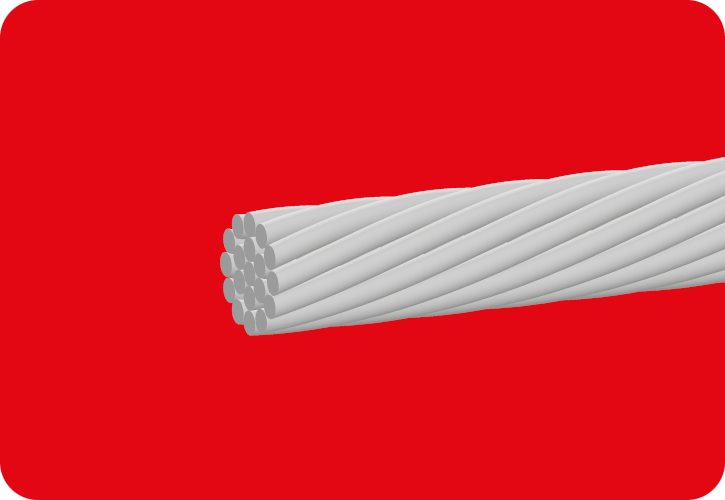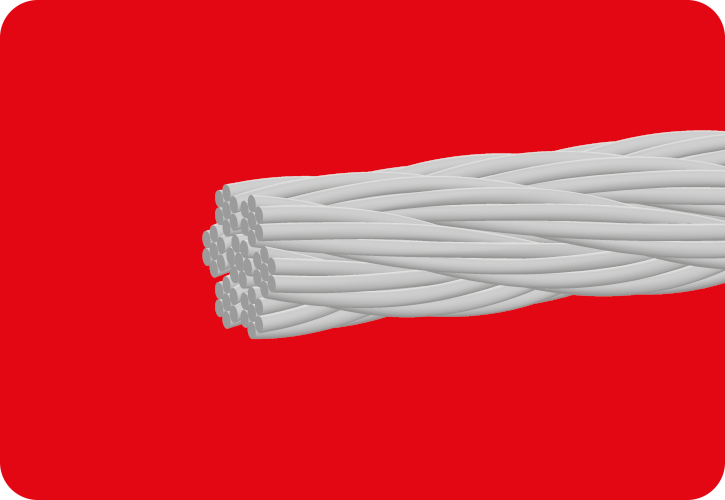Cable Core – Wire Cable
The wire cable or cable core is the heart of every Bowden cable and is mainly responsible for the transmission of the applied force. The selection of the appropriate inner cable depends on the requirements of the application. For this purpose, it must be clarified how large the force to be transmitted and required flexibility is.
The approximate bending radius of the cable core can be determined with the multiple of the diameter. For strands, a factor of 30 is used, for ropes a factor of 20 and for thin ropes a factor of 10. Ropes, strands and wire rods are not always used in combination with sheating. In order to still meet the requirements for durability, protection against wear or noise in individual applications, the wire rope variants can be coated with plastic.
Overview of Cable Cores
Strands
If the application of an actuating system requires the transmission tensile and compressive forces, stranded wires are used. The typical construction variant of the stranded wire consists of 19 individual wires. In the construction 6 wires are twisted clockwise around the core wire and 12 more wires are twisted counterclockwise in the second layer. This structure gives the strand a combination of stability and flexibility.
Technical Drawing and Data of a Strand1x19 galvanized

We will be happy to advise you on your Bowden cable solution. Please contact Mr. Rainer Schmid.
| Order-No. | Nominal- Ø D1 | Design | Calculated breaking load in N | Minimum breaking load in N | Weight in Kg/ 100m ca. |
|---|---|---|---|---|---|
| 4.01.0000.002 | 1,00 | 19 X Ø0,20 | 937 | 824 | 0,510 |
| 4.01.0000.004 | 1,25 | 19 X Ø0,25 | 1464 | 1288 | 0,798 |
| 4.01.0000.006 | 1,50 | 19xØ0,31 | 2251 | 1981 | 1,227 |
| 4.01.0000.007 | 1,70 | 19xØ0,35 | 2869 | 2525 | 1,564 |
| 4.01.0000.008 | 1,80 | 19 X Ø0,37 | 3207 | 2822 | 1,748 |
| 4.01.0000.009 | 2,00 | 19 X Ø0,40 | 3748 | 3298 | 2,042 |
| 4.01.0000.012 | 2,50 | 19xØ0,50 | 5857 | 5154 | 3,192 |
| 4.01.0000.013 | 3,00 | 19 X Ø0,60 | 8434 | 7422 | 4,596 |
Technical Drawing and Data of a Strand1x19 Stainless Steel

We will be happy to advise you on your Bowden cable solution. Please contact Mr. Rainer Schmid.
| Order-No. | Nominal- Ø D1 | Design | Calculated breaking load in N | Minimum breaking load in N | Weight in Kg/ 100m ca. |
|---|---|---|---|---|---|
| 4.02.0000.004 | 1,25 | 19 X Ø0,25 | 1464 | 1288 | 0,798 |
| 4.02.0000.006 | 1,50 | 19 X Ø0,31 | 2251 | 1951 | 1,227 |
| 4.02.0000.008 | 1,80 | 19 X Ø0,37 | 3207 | 2822 | 1,748 |
| 4.02.0000.009 | 2,00 | 19 X Ø0,40 | 3748 | 3298 | 2,042 |
Wire Ropes
In a typical Bowden cable, ropes of the 7 x 7 construction type are used. In this variant, six strands are twisted around a so-called core strand. The combination of the many individual wires gives the rope very good flexibility and very high tensile strength. Wire ropes are therefore particularly suitable for transmitting the force of an actuating pull around turns and corners. A Bowden cable with a wire rope as the inner cable can mainly transmit tensile forces. Compressive forces can only be transmitted in exceptional cases to a very limited extent, and torsional forces cannot be transmitted.
Technical Drawing and Data of a Wire Rope 7×7 galvanized

We will be happy to advise you on your Bowden cable solution. Please contact Mr. Rainer Schmid.
| Order-No. | Nominal- Ø D1 | Design | Calculated breaking load in N | Minimum breaking load in N | Weight in Kg/ 100m ca. |
|---|---|---|---|---|---|
| 4.51.0000.004 | 1,00 | 7×7 | 824 | 725 | 0,400 |
| 4.51.0000.003 | 1,25 | 7×7 | 1184 | 1042 | 0,645 |
| 4.51.0000.001 | 1,50 | 7×7 | 1746 | 1536 | 0,951 |
| 4.51.0000.005 | 2,00 | 7×7 | 2924 | 2573 | 1,593 |
| 4.51.0000.009 | 2,50 | 7×7 | 4736 | 4121 | 2,442 |
Tin Wire Ropes
A special version of the cable core is the so-called thin wire rope. This rope is made up of seven strands which are each made up out of 19 individual wires.
Thin ropes are used for Bowden cables, which require a particularly high degree of flexibility in their use case. Due to the high flexibility of the thin wire ropes, it is only possible to transmit tensile forces. When subjected to compressive loads, this type of inner cable immediately bulges.
Technical Drawing and Data of a Thin Wire Rope 7×19 Stainless Steel

We will be happy to advise you on your Bowden cable solution. Please contact Mr. Rainer Schmid.
| Order-No. | Nominal- Ø D1 | Design | Calculated breaking load in N | Minimum breaking load in N | Weight in Kg/ 100m ca. |
|---|---|---|---|---|---|
| 4.52.0000.043 | 1,00 | 7×19 | 791 | 696 | 0,380 |
| 4.52.0000.162 | 1,50 | 7×19 | 1659 | 1460 | 0,903 |
| 4.52.0000.068 | 2,00 | 7×19 | 2778 | 2164 | 1,513 |
Wire Rod
Wire rods consist of a single wire and therefore behave particularly rigidly against bending along the longitudinal axis. They are therefore used in Bowden cables to transmit compressive forces. Of course, it is also possible to transmit tensile forces and, to a certain extent, torsional forces. When using wire rods, work hardening must be considered. When the wire rods is repeatedly and strongly bended on a single spot it can break due to material fatigue.
Technical Drawing and Data of a Wire Rod

We will be happy to advise you on your Bowden cable solution. Please contact Mr. Rainer Schmid.
| Order-No. | Nominal- Ø D1 | Tensil strength N/mm2 | Material- type | Weight in Kg/ 100m ca. |
|---|---|---|---|---|
| 3.90.0000.004 | 0,80 | 2050/ 2300 | blank | 0,395 |
| 3.90.0000.002 | 1,25 | 2150/ 2380 | blank | 0,963 |
| 3.90.0000.001 | 1,50 | 1370/1570 | blank | 1,390 |
| 3.90.0000.005 | 1,50 | 2090/2310 | blank | 1,390 |
| 3.90.0000.003 | 1,60 | 2060/ 2290 | blank | 1,580 |
| 3.92.0000.001 | 1,50 | 1370 / 1570 | galvanized | 1,390 |
| 3.92.0000.003 | 1,50 | 2090/2310 | galvanized | 1,390 |
| 3.91.0000.004 | 0,80 | 1900 /2150 | stainless | 0,397 |
| 3.91.0000.005 | 1,00 | 1800 /2050 | stainless | 0,620 |
| 3.91.0000.002 | 1,25 | 1800 /2050 | stainless | 0,969 |
| 3.91.0000.001 | 1,40 | 1800 /2050 | stainless | 1,216 |
| 3.91.0000.003 | 1,50 | 1700 / 1950 | stainless | 1,400 |










